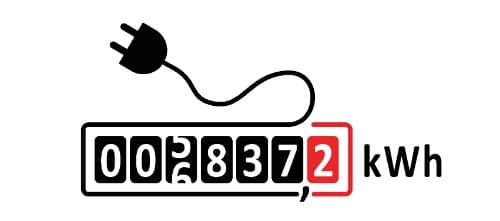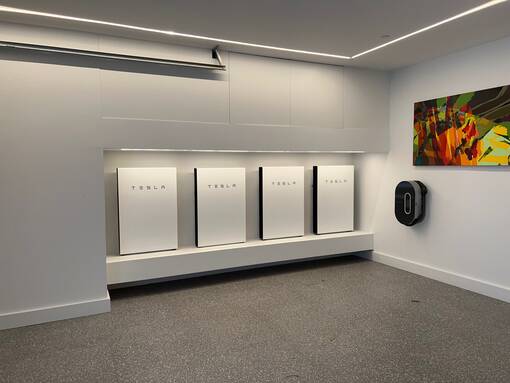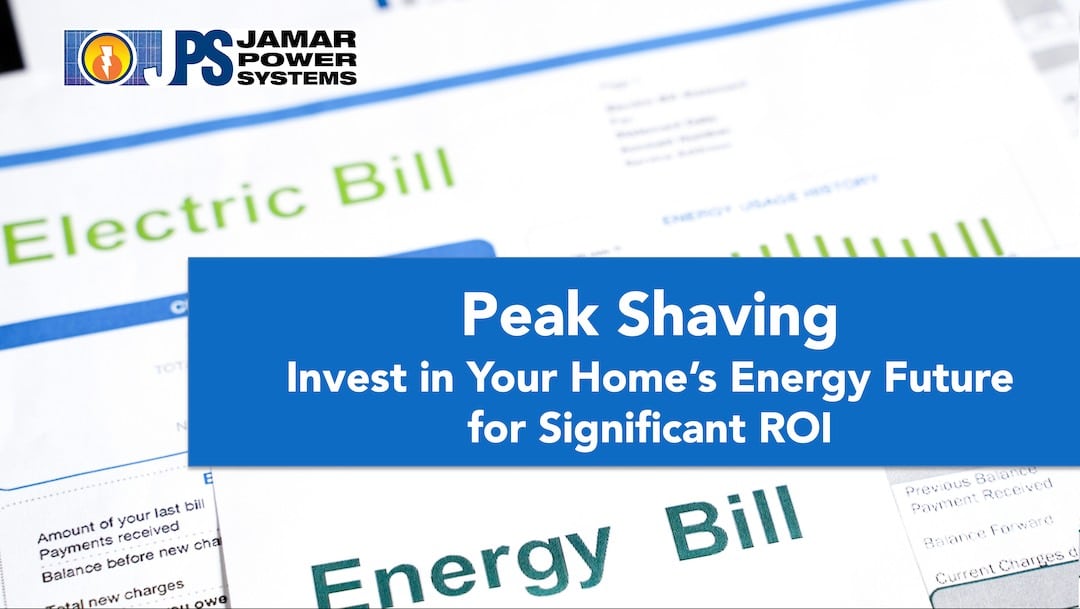Peak Shaving
Invest in Your Home’s Energy Future for Significant ROI
There are a variety of situations where installing a battery storage system makes sense.
There may be non-financial reasons why a stand-alone battery storage system is an important need.
Those include the need to keep medical equipment running during a utility power outage and the need to power business equipment during a utility company power outage for a home-based business.
But for most households, the decision is a financial one.
Will a battery storage system help you save money?
It depends of many factors but oftentimes the return on investment pencils out nicely (example).
Let’s explore a little more to see if it’s rght for your home.

What is peak shaving?
Peak shaving is a strategic way to save money on your electricity bills.
It works by taking advantage of the difference in electricity costs during peak and off-peak hours.
During off-peak hours, when electricity demand is low, and rates are cheaper, you can charge a home battery system with electricity from the grid.
Then, during peak hours, when electricity demand is high, and rates are more expensive, you can use the stored power in your battery instead of drawing expensive electricity from the grid.
This approach not only helps you save money but also helps balance the load on the power grid, contributing to a more stable and efficient energy system.
By using peak shaving, you’re effectively buying low and using high, optimizing your energy usage for maximum savings.

What are the benefits of peak shaving for homeowners?
Peak shaving using a stand-alone battery to store off-peak electricity from the utility company offers several benefits including:
+ Cost Savings: Homeowners can significantly reduce their energy bills by storing electricity during off-peak hours when rates are lower and using it during peak hours when rates are higher.
+ Increased Energy Independence: With a battery storage system, homeowners reduce their reliance on the grid, gaining more control over their energy usage and costs.
+ Potential for Earnings: In some areas, utilities offer demand response programs, paying customers to lower their electricity usage during peak demand periods. A battery storage system allows homeowners to participate in these programs for additional savings or earnings.
+ Long-Term Investment: As electricity prices rise, the potential cost savings from peak shaving increase, making a battery storage system a wise long-term investment.
+ Reduced Carbon Footprint: Using a battery to store and use electricity more efficiently can help lower a home’s carbon footprint, contributing to environmental sustainability.
Please note that the effectiveness and financial viability of battery storage for peak shaving can depend on various factors, including local energy prices, the specific characteristics of the building or facility in question, and the capacity and efficiency of the storage system.

What equipment is needed for peak shaving?
For peak shaving, the essential equipment revolves around a battery backup system.
Here’s what a typical system includes:
+ Battery Energy Storage System: The core component of your setup, this system stores energy during off-peak hours when electricity is cheaper and discharges it during peak hours when rates are higher.
+ Energy Management System (EMS): This crucial technology monitors your energy usage in real-time, controls when your battery charges and discharges, and ensures that your system operates at peak efficiency. Most modern Lithium-type batteries have built-in EMS systems.
+ Inverter: This device converts the direct current (DC) electricity stored in your battery into alternating current (AC) electricity used in your home. Most AC batteries have built-in inverters.
+ Metering Equipment: This is needed to accurately measure your electricity use and the electricity produced by your battery, which is necessary for calculating savings and potential paybacks from your utility company. Many batteries come with smart phone apps that monitor this data.
+ Possible Solar Panels: If you want to enhance your energy independence further, consider installing solar panels. These will generate electricity during the day, which can be stored in your battery for use during off-peak hours.
Remember, the specifics of your setup may depend on your home, your energy needs, local regulations, and other factors. Consulting with a professional can help ensure you get a system that’s right for you.

What important factors determine of peak shaving is good for your household?
Deciding if peak shaving is right for your household involves considering several important factors:
Household Considerations:
Annual Kilowatt Usage: Review your home’s kilowatt usage history for the past year.
Time-of-Day Usage: Analyze the kilowatt-hours (kWh) consumed during peak and off-peak hours.
Existing Electric Loads: Consider any electric loads that have been added or reduced recently.
Future Electric Loads: Forecast any electric loads expected to be added or decreased in the next 12 months.
Utility Company Factors:
Current Rate Plan: Understand the electric rate plan you are currently on.
Availability of Time-of-Use Plans: Check if your utility company offers Time-of-Use plans with different rates for peak and off-peak hours.
Seasonal Rate Differences: Look at the summer and winter daytime peak rate prices, nighttime off-peak rate prices, and understand the differences between prices per kilowatt-hour (kWh).
Battery System Considerations:
Storage Capacity: Know the kilowatt-hours (kWh) your battery system can store.
Maximum Depth of Discharge (DoD): Understand the recommended maximum DoD for your battery system.
Battery Life Cycle: Be aware of the guaranteed number of battery cycles over the system’s lifetime.
Warranty: Review the warranty terms for your battery system.
By understanding these factors, you can make an informed decision about whether peak shaving is a viable option for your household.

Is peak shaving worth it?
Whether peak shaving is worth it for you depends on a detailed analysis of your energy usage, utility rates, and the potential savings from a battery storage system.
With that said, here’s an example of math we do to figure it out for our clients:
Math formula:
1 Your household average daily kilowatt hours usage (kWh) during the daytime (for summer peak rates) = _____ kWh (can call the utility company to get these figures) x 30 days = monthly peak rate kWh usage in summer.
2. Multiply battery storage kWh capacity by maximum percent recommended Depth of Discharge (DoD) = maximum kWh battery can provide per day (will that cover your peak usage, or do you need more than one battery?)
3. Difference between utility company summer day (peak) and night (off-peak) prices per kilowatt hour (kWh) = $0.____ kWh
4. Subtract off-peak rate cost per kWh from peak rate cost per kWh = $_______ per kWh difference between rates.
5. Multiply the difference between rates by monthly peak rate kWh usage = $________ extra paid each month for peak rates.
6. Multiply the monthly rate difference by six months = peak rate cost difference (summer).
7. Repeat this formula for Winter rates.
8. Add the six-month peak rate difference total to the winter peak rate difference total = $_______ annual peak rate cost difference being paid.
9. List the minimum number of cycles the battery is guaranteed for.
10. Divide the number of battery cycles by 365 days to get the number of years the battery is guaranteed to last.
11. Divide the solar battery system’s net cost (after 30% federal tax credit, which ends Dec 31, 2025) by the number of years its cycles are guaranteed for (e.g., $10,000 / 10 years = $1,000 per year) = net cost per year for solar battery.
12. Subtract annual battery system costs from annual peak rate difference costs = net annual electricity cost $ savings using a solar battery.

Battery Financials (Example)
An Enphase 5P battery designed for peak shaving only (no grid backup) costs $6,500 minus the 30% federal income tax credit = $4,550 net cost for the battery system.
The Enphase 5P battery is rated for 6,000 cycles. One cycle = one charge and one discharge per day.
6000 cycles divided by 365 days = 16.44 years expected minimum lifespan of the battery.
$4,550 net cost of battery (after ITC tax credit) divided by 16.44 years lifespan = $277 per year annual battery cost.
$925 annual peak rate savings (if cycled daily) – $277 annual battery cost = $648 annual savings
$648 annual savings / $4550 net cost = a 7 year payback.
$648 annual savings at a $277 annual cost = a 134% initial annual ROI.
The above calculations assume you are peak shaving meaning you charge the battery with excess solar energy and discharging during peak rate periods.
Greater savings are realized as power rates rise offset by less battery capacity with age.
Enphase 5P batteries are warrantied for >60% capacity, up to 15 years or 6,000 cycles whichever comes first. Enphase is a high quality product, so expect your 5P battery’s life to exceed the warranty period.
[2025 UPDATE] THESE TAX CREDITS NOW END ON DECEMBER 31, 2025 as a result of the 2025 Budget Reconciliation Bill passed by Congress and signed by the President July 4, 2025.
Disclaimer: This is just an example, but it gives you an idea of what may be possible if your electricity usage is high enough and the differences in peak and off-peak rates in your area are large enough.
Sources:
What does this all mean?
Under NEM 3.0 adding a peak shaving battery when purchasing a new solar system can be a smart investment under the right conditions.
Contact us today at (619) 448-7770 to have us crunch the numbers for you to see if peak shaving is a smart investment for your household.
Related articles:
2025 Federal tax credit changes for solar & solar batteries
Solar panel monitoring service
Battery storage system fundamentals
Peak Shaving: Invest in your home’s energy future for significant ROI
Why a battery makes financial sense with solar panels now under NEM 3.0
How long will a solar battery last during a power blackout?
How many batteries are needed to power your home?
How many years do solar batteries last?
Solar Battery or generator for emergency backup power?
How to check if your solar panels are charging the solar battery
Complete Guide to Solar PPA, Lease vs Buying Solar
How to choose a solar installer
Get a FREE solar anaylsis to see if solar energy or a battery is right for your home
- 2025 Federal Tax Credit Changes For Solar Panel Systems & Solar Batteries - July 8, 2025
- How Solar Batteries Work - March 4, 2024
- Solar Battery or Generator for Emergency Backup Power? - January 30, 2024



